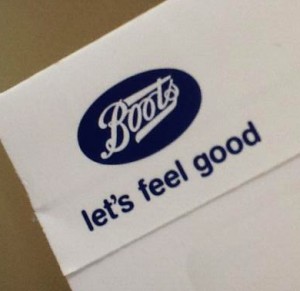What a difference a word makes
I noticed recently that Boots had tweaked its brand tagline ‘Feel Good’ into ‘Let’s Feel Good’. The change was actually made late in 2012 (if not earlier), when Mother London produced the Christmas ad below. The spot picks up the ‘Let’s’ theme with the line ‘Let’s give gifts that keep on giving’, and also restates the main tagline. (I haven’t been able to discover whether Mother actually wrote the line.)
I always thought ‘Feel Good’ was a great slogan. It encompasses every reason you might have for going to Boots, from treating a minor illness to pampering yourself or grabbing lunch. Yet it does all that with just two solid, familiar words and a reassuringly solid disyllabic cadence.
It’s also a direct command to the reader, which is always powerful, and it’s telling them to do something they want to do, which is even more powerful. The implied corollary is ‘by visiting Boots’ – that is, the understood meaning of the line is ‘Come to Boots and feel good’.

Technically, ‘Let’s Feel Good’ is not a major change. The line is still only three words, with a nice bang-bang-bang rhythm, and the tone is just as colloquial as the previous version, if not more so.
In terms of brand values, though, that one little word makes a big difference, moving the slogan from a traditional ‘interruptive’ stance to a more modern, ‘engaging’ one.
‘Feel good’ is the command of a monolithic, godlike brand that expects you to obey. If you buy into the values that it offers, you must do what it says. (See also: ‘Just do it’.)
It also presents as a one-to-one communication. The brand is speaking, and you, the individual consumer, are listening. If the message resonates, you go to Boots, buy something and ‘feel good’.
In contrast, ‘Let’s Feel Good’ is the exhortation of one friend to another. It’s less direct, more collective, positioning speaker and listener as equals rather than master and servant. As a result, the message is a bit diffused. Who is the ‘us’ posited by ‘let’s’, and what relationship with the brand is being implied? How, exactly, do you feel good along with Boots?
Obviously, the shift towards plurality aligns the slogan with the general trend towards socialness. In the context of the Mother ad above, it also links it with a warm, inclusive ‘goodwill to all men’ Christmas vibe. But is that the right stance at other times of year, when gifts and togetherness are less important?
Personally, I think the bog-standard Boots visit is probably more likely to be solo than communal, in both concept and execution. Whether you’re picking up some athlete’s foot cream or testing perfumes, you’re basically thinking about yourself. There’s certainly a social dimension to looking or smelling good, but Boots as a brand is part of the getting ready, not the going out.
As a call to action, ‘Let’s Feel Good’ is cajoling or suggesting rather than commanding. It’s talking you round rather than telling you what’s what. Compared to its predecessor, it trades authority for warmth.
Does that compromise the brand, or empower it? I’m undecided, although I can see the reasoning behind the change. Either way, it certainly shows what a big difference one small word can make.